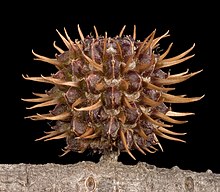| Allocasuarina corniculata | |
|---|---|

| |
| Branchlets and young female inflorescences | |
| Scientific classification | |
| Kingdom: | Plantae |
| Clade: | Tracheophytes |
| Clade: | Angiosperms |
| Clade: | Eudicots |
| Clade: | Rosids |
| Order: | Fagales |
| Family: | Casuarinaceae |
| Genus: | Allocasuarina |
| Species: | A. corniculata |
| Binomial name | |
| Allocasuarina corniculata (F.Muell.) L.A.S.Johnson | |

| |
| Occurrence data from AVH | |
| Synonyms | |
| |

Allocasuarina corniculata is a species of flowering plant in the family Casuarinaceae and is endemic to the south-west of Western Australia. It is an erect to spreading, dioecious shrub that has more or less erect branchlets, the leaves reduced to scales in whorls of six to eleven, the mature fruiting cones 8–15 mm (0.31–0.59 in) long containing winged seeds (samaras) 3–4 mm (0.12–0.16 in) long.
Description
Allocasuarina corniculata is an erect to spreading, dioecious shrub that typically grows to a height of 1–5 m (3 ft 3 in – 16 ft 5 in). Its branchlets are more or less erect, up to 260 mm (10 in) long, the leaves reduced to erect, scale-like teeth 0.3–0.6 mm (0.012–0.024 in) long, arranged in whorls of six to eleven around the branchlets. The sections of branchlet between the leaf whorls (the "articles") are mostly 6–11 mm (0.24–0.43 in) long and 0.9–1.4 mm (0.035–0.055 in) wide. Male flowers are arranged in spikes 5–20 mm (0.20–0.79 in) long, in whorls of 10 to 16 per centimetre (per 0.39 in.), the anthers 0.5–0.9 mm (0.020–0.035 in) long. Female cones are red, glabrous and sessile or on a peduncle up to 3 mm (0.12 in) long. Mature cones are 8–15 mm (0.31–0.59 in) long and 7–9 mm (0.28–0.35 in) in diameter with sharply pointed, curved awns near the base of the bracteoles, but that falls off as the cone matures. The samaras are reddish brown and 3–4 mm (0.12–0.16 in) long.
Taxonomy
This species was first formally described in 1876 by Ferdinand von Mueller who gave it the name Casuarina corniculata in his Fragmenta Phytographiae Australiae, from specimens collected near Mount Churchman by Jess Young. It was reclassified in 1982 as Allocasuarina campestris by Lawrie Johnson in the Journal of the Adelaide Botanic Gardens. The specific epithet (corniculata) means "with a small, hornlike appendage".
Distribution and habitat
This sheoak grows in tall heath on sandplains between Wubin and Norseman in the Avon Wheatbelt, Coolgardie, Esperance Plains, Mallee and Murchison bioregions of south-western Western Australia.
Conservation status
Allocasuarina corniculata is listed as "not threatened" by the Government of Western Australia Department of Biodiversity, Conservation and Attractions.
References
- ^ "Allocasuarina corniculata". Australian Plant Census. Archived from the original on 17 May 2023. Retrieved 17 May 2023.
- ^ "Allocasuarina corniculata". Australian Biological Resources Study, Department of Agriculture, Water and the Environment: Canberra. Archived from the original on 21 May 2023. Retrieved 17 May 2023.
- ^ "Allocasuarina corniculata". FloraBase. Western Australian Government Department of Biodiversity, Conservation and Attractions.
- "Casuarina corniculata". APNI. Retrieved 17 May 2023.
- von Mueller, Ferdinand (1876). Fragmenta Phytographiae Australiae. Vol. 10. Melbourne: Victorian Government Printer. pp. 62–63. Archived from the original on 12 July 2020. Retrieved 17 May 2023.
- "Allocasuarina campestris". APNI. Retrieved 17 May 2023.
- William T. Stearn (1992). Botanical Latin. History, grammar, syntax, terminology and vocabulary (4th ed.). Portland, Oregon: Timber Press. p. 391.
| Taxon identifiers | |
|---|---|
| Allocasuarina corniculata |
|
| Casuarina corniculata | |